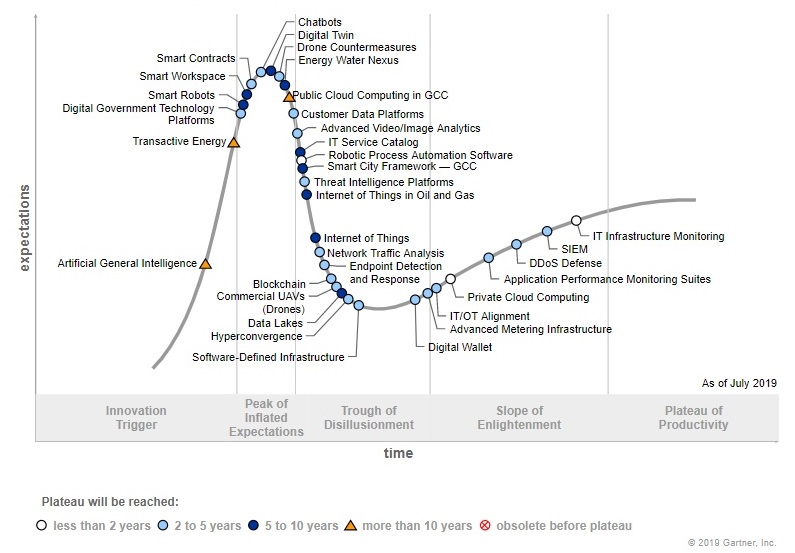RPA or API: Which is Your Ideal Match?
The Gartner Hype Cycle provides a graphic representation of the maturity and adoption of technologies and applications. It also reveals how these technologies can be relevant to solving real business problems. Companies can use this tool to understand how a specific type of technology stacks up against its promises.
It includes five stages:
- Innovation Trigger
- Peak of Inflated Expectations
- Trough of Disillusionment
- Slope of Enlightenment
- Plateau of Productivity
In 2020, Robotic Process Automation (RPA) was plotted on the downward slope of the Peak of Inflated Expectations.
Based on Gartner’s designation, this means that RPA is producing many success stories, but they are also accompanied by failures.
Sometimes, these failures come from a company pushing a solution to operate beyond its intended use. Other times, it can result from failing to properly plan or define the requirements for the project.
Although RPA has proven very useful in many use cases, it is not always the right tool to solve your problems. As a result, it’s important to have a collection of capabilities, like a toolbox, at your disposal. This way, you can select the right tool for the job. You want to select the right tool, or you will be left feeling like you are assembling a bookshelf that requires Philips screws with only a flathead screwdriver in hand.
Chris Krause, Vice President and Principal consultant with Naviant, joined me to share his tips to guide you toward the right integration tool for your process: Robotic Process Automation (RPA) or Application Programming Interface (API).
RPA vs API Integrations - How to Determine the Best Solution for You
RPA vs. API: How to Choose the Right Tool for Your Process
Know the Difference:
Let’s start with the definitions of both of these tools and how they will support your transformation goals:
RPA: RPA is a technology that streamlines mundane, repetitive processes. The robot can emulate these types of repetitive tasks. To do this, the robot can complete mouse clicks and keystrokes like entering data, rather than relying on a human to do the task. RPA can also be used to integrate applications at the surface level like other screen scraping integration techniques.
API: An API is a pre-defined set of rules or protocols that allow applications to share information back and forth. Think of it as a common language that applications can use to exchange information. Modern software platforms use these protocols to enable integrations with different types of solutions easily. APIs give you the flexibility to simplify the design, administration, and use of your integrations.
When to Use RPA vs. API:
There is a time and place for you to use both technologies in your integration strategy, so what factors should you consider?
Well, Chris’ first suggestion is to take an API-first approach to integrating. An API will provide a quick integration (sometimes even real time), purpose-built integration that is secure. But that is not always a viable option. So here are a few other questions to review when selecting the right tools:
Cost and Timeline
Sometimes, you need to deploy a solution to support an immediate business need, and there is simply not enough time to deploy a custom API solution. RPA can provide a quick and easy implementation that supports the transfer of information between your applications with a relatively low cost to maintain.
Age of Integrated Solutions
Many older legacy systems, whether commercial software or homegrown applications, do not expose APIs, so it can be difficult to integrate them with other solutions. RPA’s ability to simulate human interactions with legacy systems allows them to wrap around legacy solutions to support new functionality rather than replacing them entirely.
Flexibility Needed
Upgrades, enhancements, and changes to applications happen more and more regularly as we move further into the world of SaaS Solutions and Ever-green cloud solutions. As these changes occur, RPA solutions may not be able to complete the work initially intended during configuration. Even a slight change can throw off a bot, making RPA a more brittle integration option in certain scenarios.
Speed of Integration Needed
Real time, or near time? If the answer is that you need real time information to drive decision-making with in your process, API integrations provide you with the ability to keep systems in lock-step.
Complexity of the Solution
RPA is a great fit for simple low-risk integrations, but for complex integrations with substantial amounts of data and potential security concerns, API-based integration is a safer and more reliable approach. Most enterprise business processes are more nuanced than an RPA process can handle independently, so an API is the best alternative when you can leverage them.
Subscribe to the Naviant YouTube Channel
To catch more Question Corners, plus OnBase training webinars and other video content, subscribe to the Naviant YouTube channel.
Want More Content Like This?
Subscribe to the Naviant Blog. Each Thursday, we’ll send you a recap of our latest info-packed blog so you can be among the first to access the latest trends and expert tips on workflow, intelligent automation, the cloud, and more.




